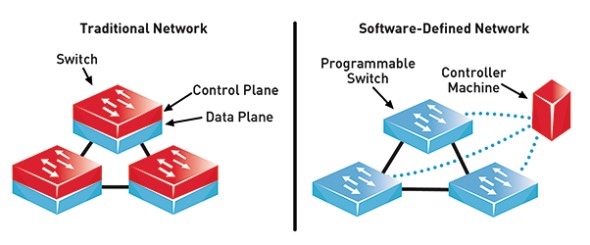SDN is referred to a Modern approach of Networking where the control is decoupled from hardware and implemented in software.
SDN architecture consists of three layers.
Application layer
Includes applications that deliver services, such as switch/network virtualization, firewalls, and load balancers. These are abstracted from the bottom layer
Software Layer
Software Defined Controller removes the control plane from the network hardware and runs it as software
Physical Network Layer
Consists of Network Hardware Infra like Switches and Routers.
The main distinguishing factor of SDN is the separation of the data plane from the control plane in Network Equipments like routers and switches as opposed to Traditional Network Infrastructure in which proprietary switches and Routers manages both Control and Data Plane making the approach Hardware Driven.
In SDN the implementation of the control plane is via software within the servers and is separate from networking equipment (Switches/routers), while the data plane is implemented within networking hardware or equipment.
This helps Customers in managing the entire network consistently and holistically, regardless of the underlying network technology.
Characteristics of Software Defined Network:
Hardware Agnostic
Services and applications running on SDN technology are abstracted from the underlying technologies and hardware that provide physical connectivity from network control. Applications will interact with the network through APIs, instead of management interfaces tightly coupled to the hardware.
Centralized Management and Advance Security Features
With the kind of centralized control, an SDN-based network provides bandwidth management, restoration, advanced security and policies which can be highly intelligent and optimized as per the customers need.
Network Overlay
Another SDN characteristic is a Network Overlay. In this case, rather than building an entire logical SDN network from scratch, the SDN implementation is built as an overlay in order to leverage a physical network that already exists. The overlay is created using virtual switches inside hypervisors. These set up tunnels that make use of the underlying physical network, but don't need to actually configure the hardware to send traffic to its destination. This is done using “Network Encapsulation”.
Rapid Speed of Deployment
By decoupling the hardware from the software, operators/customers can introduce innovative, differentiated new services rapidly free from the constraints of closed and proprietary platforms
Network Orchestration
Orchestration of network resources increases your service agility while reducing operational overheads
Benefits of Software Defined Networking:
Software defined networking offers numerous benefits including
On-demand & Automation of network provisioning
Integration with Public Cloud
Centralized Management
Enhanced security
Lower operational costs
Lower capital expenditure costs
What Kaigen Offers:
We have the right skill set to analyze & understand the customer environment.
We at Kaigen use latest technologies and best management practices to design an SDN framework, which not only suffices your present needs but is scalable to adapt to your future business requirements. With such a network in place, our customers can adapt ever evolving data-intensive applications such as, big data, virtualization, and cloud computing.
We specialize in our core competency of analyzing and assessing the current network infrastructure, identifying the bottlenecks, and plan the future demand road map using the innovative and descriptive technologies such as Network Automation.
Certified engineers having hands on experience of deploying Network virtualization solutions
Experience of deploying SD-WAN technology

